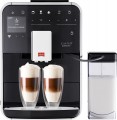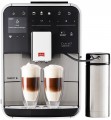A function that allows the user to compose coffee recipes at their discretion by himself. In the
“custom program” mode, you can set the main cooking parameters: grinding degree (almost all coffee makers with this mode are equipped with coffee grinders), temperature and amount of water, operating pressure, etc. At the same time, the prepared recipe can be saved in the memory of the device, so that later you can prepare your own unique drink at the touch of a button. And some models may provide the ability to save multiple programs and even user profiles, allowing several people to use their personal sets of recipes at once.
—
Heating cups/coffee pot. Some coffee makers have a heater for cups or a coffee pot. The purpose and design of this function vary depending on the type of coffee maker. For espresso coffee makers, the heater is in the form of a platform on the top of the machine, where cups are placed to be preheated before pouring espresso or espresso-based drinks. This is believed to enhance the taste and experience of the coffee. In filter coffee makers, the heater is integrated into the stand for the coffee jug, ensuring that the brewed coffee remains hot and ready to serve for an extended period of time.
—
Self-cleaning. The coffee maker is equipped with a self-cleaning function, which automatically removes scale, coffee bean residues, and other impurities. The process and effectiveness of self-cleaning may vary between different models, but overall, this function significantly simplifies the maintenance and upkeep of the coffee maker.
—
Water filter. Coffee makers may include a built-in water filter to purify the water used in the coffee preparation process. These filters operate similarly to filter jugs, with a filter cartridge installed in the water tank. The water passes through the cartridge, ensuring improved water quality before reaching the brewing unit. It's important to note that the presence of a filter is specific to coffee makers that are originally equi
...pped with such a cartridge. The capabilities of the filter may vary, but it is particularly useful if you have concerns about the water quality or want an extra layer of assurance. However, it's important to keep in mind that the filter elements need to be replaced periodically, which incurs additional costs.
— Display. A small external screen enhances the visual operation of the coffee maker. This screen displays various service information such as the active brewing program, the completion time, the remaining water volume in the tank, or the coffee level in models with a built-in grinder. It can also provide warnings about any emergency situations that may arise during the brewing process. The inclusion of this external screen allows for more convenient monitoring and control of the coffee maker's functions. We emphasize that in this case we are talking about traditional displays; touch screens are listed as a separate feature (see below).
— Touchscreen. A touch-sensitive screen, similar to those found in smartphones and tablets, is incorporated into the coffee maker. This screen not only displays various information about the device's operation but also serves as the control interface. The use of a touch screen often enhances convenience and visual appeal compared to traditional control methods such as buttons or knobs. The screen can dynamically display a wide range of visual elements, including buttons, sliders, and counters, depending on the current task. However, it's important to note that touch screens are typically found in high-end coffee makers due to their higher cost and extensive feature set.
— Touch buttons. The coffee machine's control panel features touch buttons, which offer several advantages over traditional mechanical buttons. Firstly, they require only a light touch instead of applying force. Secondly, the touchpad contributes to the coffee machine's sleek and modern appearance. Thirdly, the absence of gaps or protruding parts on the panel makes it easy to clean. However, it's worth noting that touch buttons can be more expensive and are typically found in advanced models, particularly in the middle to high-end range. It's also important to mention that touch buttons can be combined with a touch screen, although in many cases, coffee makers with touch buttons may feature a regular display.
— Control via the Internet. The coffee maker offers the convenience of remote control via the Internet. This feature can be accessed through a dedicated smartphone or tablet application or by accessing a specific webpage on any browser. With this function, users can control the coffee maker from anywhere in the world with an internet connection. It allows them to monitor the coffee maker's status, such as the current program in operation, remaining coffee or water levels, and error messages. While controlling the coffee maker via the internet may not be necessary when traveling to a different continent, it can be beneficial for various scenarios, such as pre-ordering a favorite drink on the way home from work or checking coffee supplies and purchasing more if needed. The coffee maker typically connects to the internet via Wi-Fi.
— Smartphone control. The coffee maker offers the convenience of remote control from a smartphone or other compatible device through a dedicated application. By installing the application on their device, users can turn their gadget into an interactive remote control for the coffee maker. This allows them to not only give commands to the coffee maker but also monitor its operation parameters and receive notifications. The advantage of this function is its convenience, as users no longer need to physically approach the coffee maker. The connection between the device and the coffee maker is typically established via Wi-Fi or Bluetooth, enabling reliable communication within a short range, even through walls. It's important to note that this function is distinct from control via the internet (as mentioned earlier), as it involves a direct connection between the coffee maker and the control gadget.
— Cooking timer. The coffee maker features a convenient delay start function that enables users to program the device to begin the coffee preparation process at a specific time in the future. For instance, users can set the coffee maker in the evening to have freshly brewed coffee waiting for them in the morning. Some advanced models even offer multiple timer settings, allowing users to schedule coffee preparation at different times throughout the day or on specific days of the week. This feature provides added flexibility and convenience to suit individual preferences and schedules.
— Child lock. Introducing a lock feature for the coffee maker's control panel will prevent children from accidentally turning on the device or altering its operating mode. This lock can be deactivated through a method, such as pressing multiple keys simultaneously, that is easily accessible to adults but not to children.
— 2 boilers. The coffee maker is equipped with two separate boilers for heating water. This design allows for a more efficient and faster preparation of various drinks. One boiler is dedicated to heating water for coffee, while the other generates steam for milk frothing. Without this specialization, the process of making cappuccinos and similar drinks would be time-consuming, requiring waiting for the boiler to switch between modes. Having two boilers eliminates the need for mode switching and significantly speeds up the process. Additionally, some models use a thermoblock instead of a traditional boiler for heating small portions of water directly supplied to the holder during brewing, further enhancing efficiency.
Anyway, this design is especially convenient in coffee shops, restaurants, etc., where you have to prepare different drinks and the speed of preparation is important. But if the coffee maker is planned to be used mainly for coffee drinks without milk, this function will be rather redundant.
— Thermometer. Incorporating a built-in thermometer into the coffee maker design enables precise measurement of water, milk foam, and the final drink's temperature. This feature allows for accurate control of the brewing process, which is highly valued by professional baristas and coffee enthusiasts who pay attention to every detail of their favorite beverage. Some thermometers are mechanical, resembling a dial with an arrow. While they may not be as precise as digital thermometers, they add an interesting and stylish element to the coffee maker's aesthetics. These mechanical thermometers often indicate temperature ranges, such as "low temperature," "optimal," and "high," using different colors on the scale rather than specific numerical values.
— Manometer. An indicator that displays the pressure in the coffee maker tank. This function is found mainly in espresso coffee makers (see “Type”): an increased steam pressure is required to make espresso, while a pressure gauge allows you to control the status of the coffee maker and check whether it is ready for use. Also, such equipment will be useful from a safety point of view: you cannot open a pressure tank, you must first make sure that it has decreased to a safe level.
— Tamper. The built-in tamper is a special device for tightly compacting coffee in the holder of an espresso coffee maker. This step is essential for achieving the desired brewing quality, as proper compaction ensures optimal density and even extraction of the ground coffee particles. While separate tamper devices are available, resembling round seals, many professional baristas prefer the convenience of built-in tampers. The main advantage is that the tamper is always in a fixed position, reducing the risk of misplacement and ensuring easy accessibility. Some advanced coffee makers with built-in grinders even integrate the tamper into the coffee dispensing mechanism, allowing users to simply turn a lever after loading the holder to tamp the coffee. Such systems are not only user-friendly but also ensure consistent tamping quality regardless of the user's skill level.
— Increased thermal insulation. The presence of reinforced thermal insulation in the tanks of the coffee maker. The general principle of this design is that the tank is equipped with double walls, in the space between which there is a vacuum or a layer of special thermal insulating material. This design minimizes heat loss, ensuring that the contents remain warm for an extended period and preventing unnecessary energy consumption for reheating. The specific tank that uses additional thermal insulation depends on the type of coffee maker. In filtration models, this pertains to the container for the brewed coffee, while in espresso machines, it applies to the milk container. It is not necessary to provide additional insulation for the water boiler in espresso machines due to various reasons, such as the use of thermoblocks with flow heating principles in many espresso machines.
